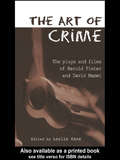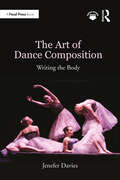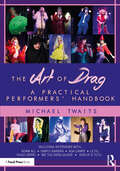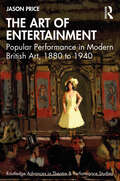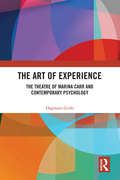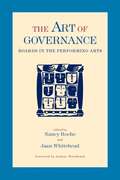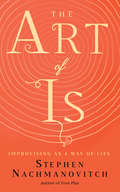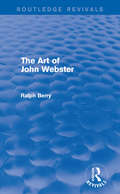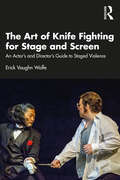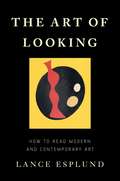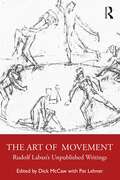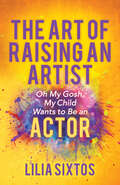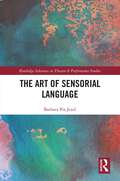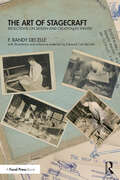- Table View
- List View
The Art of Crime: The Plays and Film of Harold Pinter and David Mamet (Studies in Modern Drama #21)
by Leslie KaneFirst Published in 2004. Routledge is an imprint of Taylor & Francis, an informa company.
The Art of Dance Composition: Writing the Body
by Jenefer DaviesThe Art of Dance Composition: Writing the Body is an introduction to modern dance composition, providing clear and structured approaches to designing and defining movement that demystify the creative process.The book introduces the concepts of creating authentic movement, processes for gathering and ordering compositional elements, and the ways in which theme, story, and design relate to bodies moving through space. It approaches the practice of composition from many avenues, including the use of digital tools such as video and video editing software, digital mapping, and motion capture, and through improvisation, sourced gestures, and inspiration from visual art, found objects, and chance methodology. Flowcharts that organize and provide a framework for making dance are included, equipping readers with a clear roadmap for creating their own work.Filled with practical advice, this book is suitable for all aspiring choreographers.The Art of Dance Composition: Writing the Body includes access to performance videos that demonstrate the concepts illustrated in the book. To access the videos, visit www.daviesanddancers.com/links-to-writing-the-body.
The Art of Drag: A Practical Performers’ Handbook
by Michael TwaitsThe Art of Drag: A Practical Performers’ Handbook is the ultimate guide for all drag kings, queens and queers who want to bring their best to the stage.Filled with a wide range of exercises and advice from working performers, this book is a guide and support for every working drag act, but also the drag-curious wanting to step a sequinned toe onto the stage for the first time. The book focuses on practical performance advice for creating new work, refining existing work and exploring new skills and perspectives from the world of drag. It also includes: Practical performance tips demystifying live performance skills such as singing, lip-sync, impersonation and comedy. Top tips on how to get bookings, get paid and make a profit. Advice on how to communicate with an audience and create an unforgettable live experience. Interviews with seven sensational acts who discuss how they use the art of drag: Adam All, Simply Barbra, Ada Campe, Hugo Grrrl, Le Fil, Me the Drag Queen and Son of a Tutu. Written by a drag act, for drag acts, The Art of Drag is an invaluable resource for new and aspiring drag performers, along with academic performance courses covering Drag, Cabaret, or Queer Performance.
The Art of Dramatic Writing: Its Basis in the Creative Interpretation of Human Motives
by Lajos EgriLearn the basic techniques every successful playwright knows! Amid the hundreds of "how-to" books out there, there have been very few which attempted to analyze the mysteries of play construction. Lajos Egri's classic, The Art of Dramatic Writing, does just that, with instruction that can be applied equally well to a short story, novel, or screenplay.Examining a play from the inside out, Egri starts with the heart of any drama: its characters. All good dramatic writing hinges on people and their relationships, which serve to move the story forward and give it life, as well as an understanding of human motives—why people act the way that they do. Using examples from everything from William Shakespeare's Romeo and Juliet to Henrik Ibsen's A Doll's House, Egri shows how it is essential for the author to have a basic premise—a thesis, demonstrated in terms of human behavior—and to develop the dramatic conflict on the basis of that behavior. Using Egri's ABCs of premise, character, and conflict, The Art of Dramatic Writing is a direct, jargon-free approach to the problem of achieving truth in writing.
The Art of Dramaturgy
by Anne CattaneoAn introduction to the mysterious theater role of a dramaturg by a legend in the field Anne Cattaneo was among the first Americans to fill the role of dramaturg, one of theater&’s best kept secrets. A combination of theater artist, scholar, researcher, play advocate, editor, and writer&’s friend, it is the job of a dramaturg to &“reflect light back on the elements that are already in play,&” while bringing a work of theater to life. Cattaneo traces the field from its beginnings in the eighteenth century to the present and chronicles the multitude and variety of tasks a dramaturg undertakes before, during, and after a production is brought to the stage. Using detailed stories from her work with theater artists such as Tom Stoppard, Wendy Wasserstein, Robert Wilson, Shi-Zheng Chen, and Sarah Ruhl, as well as the discovery of a &‘lost&’ play by Langston Hughes and Zora Neale Hurston, Cattaneo provides an invaluable manual to those studying, working in, and interested in this most fascinating profession.
The Art of Entertainment: Popular Performance in Modern British Art, 1880 to 1940 (ISSN)
by Jason PriceIn this book, theatre historian Jason Price looks at the relationships and exchanges that took place between high and low cultural forms in Britain from 1880 to 1940, focusing on the ways in which figures from popular entertainments, such as music hall serio-comics, clowns, and circus acrobats, came to feature in modern works of art.Readers with an interest in art, theatre, and the history of modern Britain will find Price’s approach, which sees major works of art used to illuminate the histories of once-famous entertainers and the wider social, political, and cultural landscape of this period, accessible and engaging. The book will bring to life for readers some of the most vivid works of modern British art and reveal how individuals historically overlooked due to their gender, sexuality, or race played a significant role in the shaping of British culture during this period of monumental social change.
The Art of Euripides: Dramatic Technique and Social Context
by Donald J. MastronardeIn this book Professor Mastronarde draws on the seventeen surviving tragedies of Euripides, as well as the fragmentary remains of his lost plays, to explore key topics in the interpretation of the plays. It investigates their relation to the Greek poetic tradition and to the social and political structures of their original setting, aiming both to be attentive to the great variety of the corpus and to identify commonalities across it. In examining such topics as genre, structural strategies, the chorus, the gods, rhetoric, and the portrayal of women and men, this study highlights the ways in which audience responses are manipulated through the use of plot structures and the multiplicity of viewpoints expressed. It argues that the dramas of Euripides, through their dramatic technique, pose a strong challenge to simple formulations of norms, to the reading of consistent human character, and to the quest for certainty and closure.
The Art of Experience: The Theatre of Marina Carr and Contemporary Psychology
by Dagmara GizłoThe Art of Experience provides an interdisciplinary analysis of selected plays from Ireland’s premier female playwright, Marina Carr. Dagmara Gizło explores the transformative impact of a theatrical experience in which interdisciplinary boundaries must be crossed. This book demonstrates that theatre is therapeutic and therapy is theatrical. The role of emotions, cognitions, and empathy in the theatrical experience is investigated throughout. Dagmara Gizło utilises the methodological tools stemming from modern empirically grounded psychology (such as cognitive-behavioural therapy or CBT) to the study of theatre’s transformative potential. This book will be of great interest to students and scholars of theatre, performance, and literature, and will be a fascinating read for those at the intersection of cognitive studies and the humanities.
The Art of Governance
by Nancy Roche Jaan WhiteheadThe Art of Governance is an essential guide for trustees in the performing arts and for the artists, managers, and community leaders who work with them. This book provides the larger context in which trustees govern--the art, artists, history, institutions, and national policies of the performing arts--and also explores more practical issues, such as board development, planning, finance, and fundraising. A wide range of distinguished artists, trustees, managers, and consultants have contributed articles, covering everything from "The Art of Theater" to "Understanding Financial Statements." An invaluable tool for building an enlightened and inspired board, this resource above all recognizes the need of trustees in the performing arts to find a balance between the uncertainty of artistic creativity and the need for fiscal stability.Editors Nancy Roche and Jaan Whitehead have served on the boards and staff of numerous theater organizations.Nancy Roche has been a trustee of CENTER-STAGE in Baltimore since 1987, serving as president of the board for seven years and as interim managing director for one year. She has been a consultant on governance for the National Arts Stabilization (now National Arts Strategies), a councilor of the Maryland State Arts Commission from 1992-1999, and has twice served as lay panelist for the NEA. In the summer of 2000, she participated as a theater trustee in the National Critics' Institute at the Eugene O'Neill Theater Center in Waterford, Connecticut, returning in the following summer as a founding member of their week-long Trustees Program. She is a founding member of the National Council for the American Theatre and serves as a trustee and treasurer of the board of Theatre Communications Group. In addition, she serves on the boards of the Roland Park Country School, the Institute for Christian-Jewish Studies, and the Baltimore School for the Arts. She is a graduate of Dominican University and received an MA in teaching and an LLA, both from The Johns Hopkins University.Jaan Whitehead currently chairs the board of the SITI Company, an ensemble theater in New York led by Anne Bogart. She has served on the boards of The Acting Company, Arena Stage, Living Stage, and The Whole Theatre Company, where her particular interests have been board development and institutional change. She has also been a trustee of Theatre Communications Group and the National Cultural Alliance, an arts advocacy group in Washington, and is a founding member of the National Council for the American Theatre. In addition to her work as a trustee, she has been executive director of Theatre for a New Audience in New York and Development Director of CENTERSTAGE in Baltimore.Ms. Whitehead graduated from Wellesley College, holds and MA in economics from the University of Michigan, and, early in her career, works as an economist for private industry and the Federal Reserve Board. She received her PhD in political theory fro Princeton in 1988. She taught at Georgetown University for several years but, as her involvement in theater deepened, she made the arts her main work while retaining her interests in economic and political theory. Drawing on this background, she has recently been writing a series of essays on the challenges facing the arts in a commercial society.
The Art of Is: Improvising as a Way of Life
by Stephen NachmanovitchA MASTERFUL BOOK ABOUT BREATHING LIFE INTO ART AND ART INTO LIFE &“Stephen Nachmanovitch&’s The Art of Is is a philosophical meditation on living, living fully, living in the present. To the author, an improvisation is a co-creation that arises out of listening and mutual attentiveness, out of a universal bond of sharing that connects all humanity. It is a product of the nervous system, bigger than the brain and bigger than the body; it is a once-in-a-lifetime encounter, unprecedented and unrepeatable. Drawing from the wisdom of the ages, The Art of Is not only gives the reader an inside view of the states of mind that give rise to improvisation, it is also a celebration of the power of the human spirit, which — when exercised with love, immense patience, and discipline — is an antidote to hate.&” — Yo-Yo Ma, cellist
The Art of John Webster (Routledge Revivals)
by Ralph BerryThe Art of John Webster, first published in 1972, is a study of the three extant plays of Webster known to be solely his work. These plays are seen as attempts to achieve in literature the effects of the baroque, a term which related Webster to the larger developments of European art. Their content is analysed in terms of a consistent opposition between evil and the law. The book seeks to re-establish a base for the claims that must be made for Webster as a serious artist. This title will be of interest to students of literature and drama.
The Art of Knife Fighting for Stage and Screen: An Actor’s and Director’s Guide to Staged Violence
by Erick Vaughn WolfeThe Art of Knife Fighting for Stage and Screen: An Actor’s and Director’s Guide to Staged Violence provides detailed information for the safe use of knives and daggers in a theatrical setting and an in-depth understanding of safe theatrical weapons. The book starts with an extensive safety review, then moves on to the basic techniques of dagger fighting, starting with grip and body postures. Readers will then learn about the basic actions of cuts, parries, blocks, and disarms. During this process, they will explore the connection between body and weapon and start learning the elements of storytelling through choreography. Special attention is given to suicides, threats, and murder and how directors, choreographers, performers, teachers, and students can approach these techniques in a way that is physically and mentally safe. The book also covers the use of throwing knives, knife flips, and other tricks to help add a little flair to your fight. The Art of Knife Fighting for Stage and Screen teaches the safe theatrical use of the knife for directors, performers, educators, and students of stage combat.
The Art of Looking: How to Read Modern and Contemporary Art
by Lance EsplundA veteran art critic helps us make sense of modern and contemporary artThe landscape of contemporary art has changed dramatically during the last hundred years: from Malevich's 1915 painting of a single black square and Duchamp's 1917 signed porcelain urinal to Jackson Pollock's midcentury "drip" paintings; Chris Burden's "Shoot" (1971), in which the artist was voluntarily shot in the arm with a rifle; Urs Fischer's "You" (2007), a giant hole dug in the floor of a New York gallery; and the conceptual and performance art of today's Ai Weiwei and Marina Abramovic. The shifts have left the art-viewing public (understandably) perplexed.In The Art of Looking, renowned art critic Lance Esplund demonstrates that works of modern and contemporary art are not as indecipherable as they might seem. With patience, insight, and wit, Esplund guides us through the last century of art and empowers us to approach and appreciate it with new eyes. Eager to democratize genres that can feel inaccessible, Esplund encourages viewers to trust their own taste, guts, and common sense. The Art of Looking will open the eyes of viewers who think that recent art is obtuse, nonsensical, and irrelevant, as well as the eyes of those who believe that the art of the past has nothing to say to our present.
The Art of Movement: Rudolf Laban’s Unpublished Writings
by Dick McCawThe Art of Movement: Rudolf Laban’s Unpublished Writings offers new perspectives on the thinking and practice of Rudolf Laban – one of the pioneers of modern European dance and movement analysis. A wealth of Laban’s previously untranslated writings broadens our understanding of his work through new perspectives on his thinking and practice. Alongside these key primary sources, interviews with Laban’s family and colleagues and editorial commentaries shed new light on the significance of his life and career. Laban’s own texts also offer further elaboration of the key themes of his work – eukinetics, choreutics, lay dance, pedagogy and dance notation. This essential companion to The Laban Sourcebook is an ideal resource for any students or scholars of modern dance, dance studies, dance history and movement analysis looking for a deeper understanding of this seminal figure in their field.
The Art of Raising an Artist: Oh My Gosh, My Child Wants to Be an Actor
by Lilia SixtosThe Art of Raising an Artist guides parents in helping their children explore the world of acting and ultimately invest in their child’s future.Actor and director, Lilia Sixtos has seen thousands of auditions and taught hundreds of artists. By raising her two creative children, she has learned every possible way a creative person’s journey can be helped or hindered by their parents. In The Art of Raising an Artist, she shows parents how to:Identify the best training they can provide for their child within their meansDevelop a safe and loving space for the challenges of their child’s journeyCreate the support team their child needsFind their child’s nicheFit the needs of their child’s career with the needs of the whole family
The Art of Sensorial Language (Routledge Advances in Theatre & Performance Studies)
by Barbara Pia JeničThe Art of Sensorial Language examines audience interactivity and multisensory experiences that can be understood internationally and cross‑culturally. It considers interactivity not as a technological mode of interaction but as a direct and immediate communication between the audience and the performers, which takes place in person and in which all participants are in contact with each other. By describing theatrical techniques and approaches for organically immersing the audience in the story, this book shows how the development of these methods is also applicable to multisensory presentations for museums and galleries. The author places particular emphasis on the development of scents and their uses for cultural and educational purposes to allow for greater and deeper immersion in an event or installation. Inspired by the work of Enrique Vargas, the inventor of sensorial language, the discussion reveals how this approach not only engages the senses but also integrates additional methods and tools to create a poetic symphony, which is particularly important for enriching user experiences in theatres, galleries and museums, as well as in other forms of immersive experiences.This study will be of great interest to experts in multisensory approaches within the fields of the arts and education, as well as specialists in cultural heritage and tourism.
The Art of Shakespeare's Sonnets
by Helen VendlerThis book critically analyses Shakespeare's sonnets quoting some of his poetic beauties.
The Art of Shakespeare's Sonnets
by Helen VendlerHelen Vendler, widely regarded as our most accomplished interpreter of poetry, here serves as an incomparable guide to some of the best-loved poems in the English language. In detailed commentaries on Shakespeare's 154 sonnets, Vendler reveals previously unperceived imaginative and stylistic features of the poems, pointing out not only new levels of import in particular lines, but also the ways in which the four parts of each sonnet work together to enact emotion and create dynamic effect. The commentaries--presented alongside the original and modernized texts--offer fresh perspectives on the individual poems, and, taken together, provide a full picture of Shakespeare's techniques as a working poet. With the help of Vendler's acute eye, we gain an appreciation of "Shakespeare's elated variety of invention, his ironic capacity, his astonishing refinement of technique, and, above all, the reach of his skeptical imaginative intent. " Vendler's understanding of the sonnets informs her readings on an accompanying compact disk, which is bound with the book. This recorded presentation of a selection of the poems, in giving aural form to Shakespeare's words, heightens our awareness of voice in lyric, and adds the dimension of sound to poems too often registered merely as written words.
The Art of Stagecraft: Reflections on Design and Creation in Theatre
by F. Randy deCelleThe Art of Stagecraft: Reflections on Design and Creation in Theatre is a thoughtful examination of the intersection of design, art, and the modern and contemporary theatrical design practitioner.Utilizing a recently discovered folio of materials of stagecraft practices that was being compiled by Mobile, Alabama artist Edmond Carl deCelle, who was nationally known for his sketches, paintings, murals, Mardi Gras pageants and parades, and theatre productions along the Gulf Coast in the years 1930–1970, the book examines methodologies of production using sketches from the artist as well as his thoughts on design, art, and the shifts that were happening in the industry during the time. The book looks at a sampling of traditional theatrical design and stagecraft practices that became formalized in the mid-20th century and compares them to contemporary practices, offering a reflection on the current state of theatre production, stagecraft practices, and the theatre practitioner as an artist.For those just coming into theatre production, The Art of Stagecraft provides a resource for a selection of well-proven, straightforward techniques that have been developed over many years. For those in theatre production, the book serves as a guide for an assortment of traditional techniques that are still in use today but may not be known by everyone. For all readers, this book will also look at a sample of traditional techniques that have been phased out in favor of contemporary methods due to the development of modern materials.
The Art of Stillness: The Theater Practice of Tadashi Suzuki
by Paul AllainFor over forty years, Tadashi Suzuki has been a unique and vital force in both Japanese and Western theater, creating and directing many internationally acclaimed productions including his famous production of The Trojan Women, which subsequently toured around the world. An intergral part of his work has been the development and teaching of his rigorous and controversial training system, the Suzuki method, whose principles have also been highly influential in contemporary theater. Paul Allain, an experienced practitioner of the Suzuki method, re-evaluates Suzuki's work, giving a lucid overview of his development towards an international theater aesthetic. He examines Suzuki's collaborators, the importance of architecture and environment in his theater and his impact on performance all over the world. The Art of Stillness is a lively, critical study of one of the most important and uncompromising figures in contemporary world theater.
The Art of Theatre: Then and Now
by William Missouri Downs Erik Ramsey Lou Anne WrightTHE ART OF THEATRE: THEN AND NOW, 4th Edition, brings the fascinating world of theatre to life with lively coverage of the history, cultural diversity, creativity, controversy -- and even a typical day in the life -- of theatre. As the authors wrote each chapter, they asked themselves how the subject applies to students' lives. The result is a text packed with practical information you can use in everyday life, including insight on censorship, freedom of speech, copyrights, the National Endowment for the Arts, and more. Timely connections drawn between theatre and TV and film help you see how the living stage is unique, and the optional MindTap digital learning solution provides a variety of online study tools to help you ensure your success in the course.
The Art of Theatrical Design: Elements of Visual Composition, Methods, and Practice
by Kaoime MalloyThe Art of Theatrical Design: Elements of Visual Composition, Methods, and Practice addresses the core principles that develop the student designer into a true artist, providing a foundation that ensures success with each production design. This text concentrates on the skills necessary to create effective, evocative, and engaging theatrical designs that support the play contextually, thematically, and visually. It gives students the grounding in core design principles they need to approach design challenges and make design decisions in both assigned class projects and realized productions. This book features: In-depth discussions of design elements and principles for costume, set, lighting, sound, and projection designs Coverage of key concepts such as content, context, genre, style, play structure and format, and the demands and limitations of various theatrical spaces Essential principles, including collaboration, inspiration, conceptualization, script analysis, conducting effective research, building a visual library, developing an individual design process, and the role of the critique in collaboration Information on recent digital drawing tool technology, such as the Wacom® Inkling pen, Wacom® Intuos digitizing tablets and digital sketching, and rendering programs such as Autodesk® Sketchbook Pro and Adobe® Photoshop® Chapter exercises and key terms designed to provide an engaging experience with the material and to facilitate student understanding
The Art of Theatrical Design: Elements of Visual Composition, Methods, and Practice
by Kaoiṁe E. MalloyThe Art of Theatrical Design: Elements of Visual Composition, Methods, and Practice, Second Edition, contains an in-depth discussion of design elements and principles for costume, set, lighting, sound, projection, properties, and makeup designs. This textbook details the skills necessary to create effective, evocative, and engaging theatrical designs that support a play contextually, thematically, and visually. It covers key concepts such as content, context, genre, style, play structure, and format and the demands and limitations of various theatrical spaces. The book also discusses essential principles, including collaboration, inspiration, conceptualization, script analysis, conducting effective research, building a visual library, developing an individual design process, and the role of the critique in collaboration. This second edition includes A new chapter on properties management and design. A new chapter on makeup design. A new chapter on digital rendering, with evaluations of multiple programs, overviews of file types and uses, and basic tutorials in Adobe® Photoshop® and Procreate. An expanded and revised chapter on traditional rendering, with the inclusion of new media, including watercolor, gouache, and mixed media, and updated exercises and tutorials. Revised and expanded chapters on individual design areas, including additional practices for conceptualization and collaboration, with new exercises for skill development. Additional exercises in all elements and principles of design chapters for investigation of each design principle and skill development. Revised and updated content throughout the text, reflecting current pedagogy and practices. This book gives students in theatrical design, introduction to design, and stagecraft courses the grounding in core design principles they need to approach design challenges and make design decisions in both assigned class projects and realized productions. The Art of Theatrical Design provides access to additional online resources, including step-by-step video tutorials of the exercises featured in the book.
The Art of Unarmed Stage Combat
by Robert NajarianThe Art of Unarmed Stage Combat is your guide to the principles and techniques of theatrical violence, combining detailed discussions of the mechanics of stage fighting with the nuances of acting decisions to make fighting styles reflect character and story. Expert Fight Director Robert Najarian offers never-before-published games and exercises that will allow you to develop the skills and concepts for performing violence for stage and screen. This title utilizes a unique system of training techniques that result in stage violence that is both physically engaging for you as a performer, while remaining viscerally engaging for the audience.
The Art of Voice Acting: The Craft and Business of Performing for Voiceover
by James AlburgerThe Art of Voice Acting covers all aspects of the craft and business of performing voiceover. This sixth edition is reorganized and completely updated to include the latest information on how to get started in voiceover, performing techniques, setting up a personal recording space, voiceover demos, the basics of running a voiceover business, working with agents, unions, and much more. Dozens of URL’s are included with additional resources and several chapters include all new scripts written specifically for this edition. Two new chapters include contributions from some of the voiceover world’s top professionals. Additional content can be found on the Voice Acting Academy website at AOVA.VoiceActing.com. This is the perfect tool for aspiring voice performers, radio announcers, and stage and screen actors.
